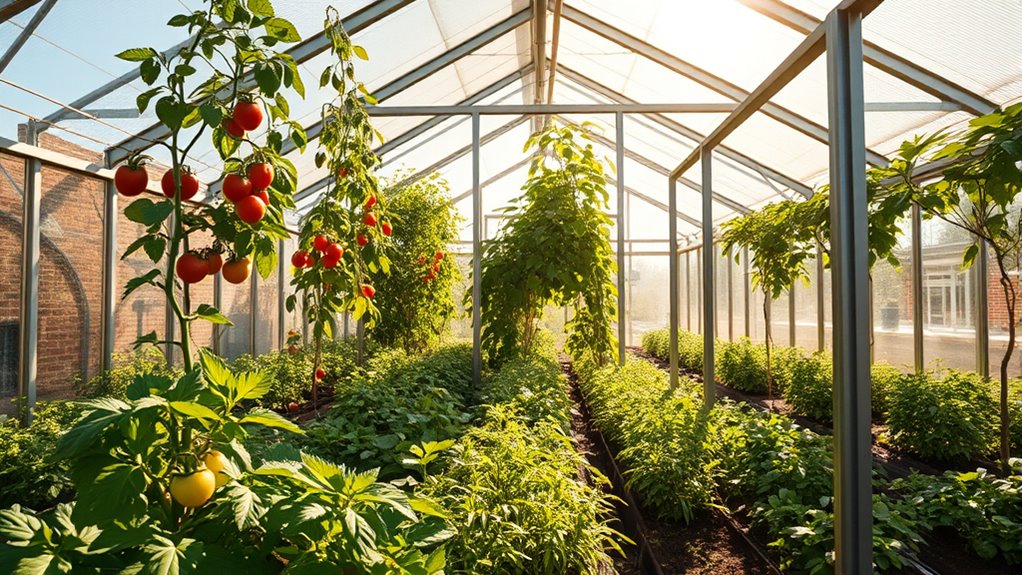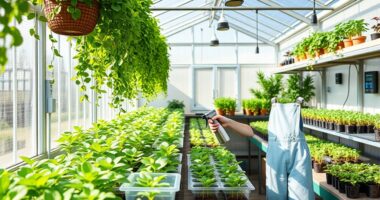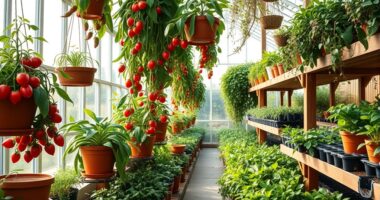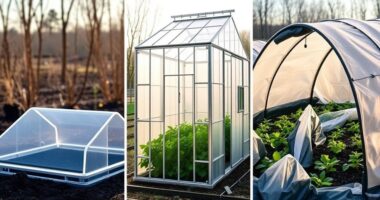Greenhouses work by creating a controlled environment that manages temperature, humidity, and light, so your plants can grow year-round regardless of outdoor weather. They often use heating, shading, ventilation, and moisture control systems to keep conditions ideal. This environment encourages healthy growth, extends growing seasons, and improves yields. As you explore further, you’ll discover how precise climate control and plant propagation techniques can help you become a confident greenhouse gardener.
Key Takeaways
- Greenhouses create a controlled environment that regulates temperature, humidity, and light to promote healthy plant growth year-round.
- Climate control systems, including heating, shading, and ventilation, maintain optimal conditions for different plants.
- They facilitate seed germination and propagation by providing stable, spring-like conditions regardless of outdoor weather.
- Automated systems help sustain ideal environments, reducing the need for manual adjustments and ensuring consistent plant health.
- Greenhouses enable diverse plant cultivation, experimentation, and learning by offering a reliable, protected gardening space.

Greenhouse gardening offers a controlled environment that allows you to grow a wide variety of plants year-round, regardless of outdoor weather conditions. This environment is designed to maximize growth by managing factors like temperature, humidity, and light—collectively known as climate control. When you enter a greenhouse, you have the ability to regulate these elements to create ideal conditions for your plants, no matter what the weather outside is doing. This control not only extends your growing season but also improves plant health and yields. Whether you’re cultivating delicate seedlings or mature crops, maintaining the right climate is essential for success.
A key advantage of a greenhouse is its capacity to facilitate plant propagation. Starting new plants from seeds or cuttings requires specific conditions that are often difficult to maintain outdoors. Inside a greenhouse, you can create a stable environment that encourages germination and root development. For example, by adjusting temperature and humidity levels, you can simulate spring-like conditions even in winter, making it easier to propagate a wide variety of plants. You can also use supplemental lighting to extend daylight hours, which encourages faster growth and more successful propagation. This control over environmental factors means you’re less dependent on seasonal changes, giving you greater flexibility and confidence in your gardening projects. Additionally, understanding the legal guidelines surrounding divorce can help you manage legal aspects of property and asset division during this process.
Climate control in a greenhouse isn’t just about keeping things warm; it’s about creating a balanced environment tailored to your plants’ needs. You might install heating systems for colder months or use shade cloths and ventilation to cool things down during hot weather. Fans and vents help circulate air, preventing mold and pests while maintaining consistent conditions. Humidifiers or dehumidifiers can fine-tune moisture levels, which are vital for seedling development and healthy plant growth. You also have the option to automate many of these systems, ensuring that your greenhouse remains at ideal conditions with minimal effort. Additionally, using cold-pressed vegetable juice as a natural supplement can promote healthy growth by providing essential nutrients. Implementing climate control systems can significantly enhance plant growth and protect against environmental stressors. This level of control helps you avoid common problems like frost damage, drought stress, or overheating, all of which can hinder plant growth or destroy delicate seedlings. Moreover, staying informed about the latest advances in AI in Education can inspire innovative solutions for managing your greenhouse environment more efficiently.
Ultimately, understanding how a greenhouse works empowers you to harness climate control and plant propagation techniques effectively. When you master these aspects, you unlock the potential to grow a broader range of plants and boost your gardening success. Your greenhouse becomes a reliable space where you can experiment, learn, and produce healthy, vibrant plants year-round. With proper management of environmental conditions, you’ll find that greenhouse gardening is not only productive but also incredibly rewarding. It’s your personalized garden haven where you have the power to nurture plants precisely how they need to thrive.
Frequently Asked Questions
How Do Greenhouses Regulate Temperature Automatically?
Greenhouses automatically regulate temperature through a combination of ventilation systems and insulation techniques. You can set up automatic vents or fans that open when temperatures rise too high, releasing excess heat. Insulation techniques, like double glazing or thermal screens, help retain warmth during cooler times. By using these features, you guarantee a stable environment, keeping plants healthy without constant manual adjustments.
What Are the Best Materials for Greenhouse Glazing?
When choosing glazing materials, you want options that maximize sunlight, minimize heat loss, and last long. Glass alternatives like polycarbonate and acrylic offer excellent durability and impact resistance, making them ideal for harsh weather. Consider glazing durability, ensuring your greenhouse stays protected over time. These materials provide clear visibility and efficient insulation, helping you maintain ideal growing conditions while reducing maintenance and replacement costs.
How Do Greenhouses Control Humidity Levels Effectively?
You control humidity levels by using effective ventilation systems and humidity sensors. Ventilation systems help regulate moisture by exchanging the moist indoor air with drier outside air, preventing excess humidity. Humidity sensors monitor moisture levels constantly, sending signals to activate fans or vents when needed. This combination keeps humidity balanced, creating an ideal environment for plant growth and preventing issues like mold or fungal diseases.
Can Greenhouses Operate Successfully in Extreme Climates?
You can operate greenhouses successfully in extreme climates by adapting their design and technology. Use solar shading to reduce heat in hot environments and maintain warmth during cold weather. Implement pest management strategies to protect plants from pests common in extreme conditions. Proper insulation, ventilation, and climate control systems ensure your greenhouse remains functional and productive, regardless of harsh weather outside.
What Are Energy-Efficient Methods for Greenhouse Heating?
To keep your greenhouse warm efficiently, consider using solar heating, which captures sunlight to generate heat during the day and reduces energy costs. Additionally, incorporate thermal mass, like water barrels or stone, to absorb heat during the day and release it at night. These methods work together to maintain a consistent temperature, saving energy while creating a more sustainable environment for your plants.
Conclusion
Now that you know how greenhouses work, imagine your plants basking in a cozy, sunlit haven, just like a child feeling safe and warm in a blanket! Greenhouses create a nurturing environment, extending your growing season and boosting plant health. Think of it as giving your garden a gentle hug, allowing your green thumb to flourish no matter the weather outside. With this knowledge, your gardening journey can flourish just like those thriving plants inside your greenhouse.









